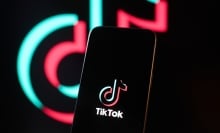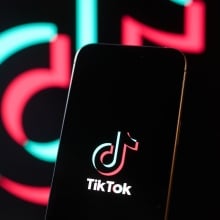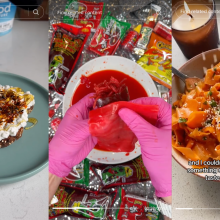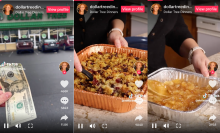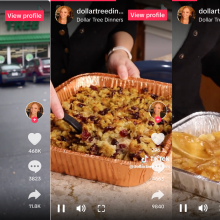According to TikTok, this is what you should know about us:
Elena drinks her morning tea out of a Moe's Books mug. She wears black Mary Jane Docs. She rotates between using a black Baggu shoulder bag and the smallest size Telfar. Her key is baby blue and reads "home" in white cursive on the head, because when she lost hers and her roommate replicated it, that was the only option. It hangs with an iridescent glass heart. Madame Bovary by Gustave Flaubert, Tomorrow Sex Will Be Good Again by Katherine Angel, Ways of Seeing by John Berger, and Essays One by Lydia Davis are on her nightstand.
Chase uses an Eleanor Roosevelt College graduate mug for her morning coffee. She wears platform checkered Vans. She treks around with a Sweet Pickles Bookstore tote bag every day, and her keychain sports a mushroom-shaped personal safety alarm, a mini Where the Wild Things Are Brooklyn Public Library card, a friendship lanyard her baby cousin made, and a carabiner. On her nightstand are these books: Acceptance by Jeff Vandermeer, Terrace Story by Hilary Leichter, Brooklyn by Colm Tóibín, and Midnight in the Garden of Good and Evil by John Berendt.
The app neatly suggests that is everything you need to know about us "girls." But what did you learn about us? Do these items categorize us as femcels, clean girls, or teenage girls in our 20s?
Tweet may have been deleted
What if, instead, we told you about our ex-boyfriends? Or our snack-filled dinners? What Taylor Swift era we are in? Would that get you closer?
Maybe you're actually asking about our trauma — no need to get into our intersecting identities or politics to understand "girlhood" here.
Because in 2023 — the "Year of the Girl" or the "Girl-aissance" — more substantial facets of your personality are on the back burner. What matters most is a superficial identification with various products and experiences that supposedly define girlhood, a term that's come to apply to select aspects of womanhood.
While media outlets and brands touted the "Year of the Girl," microtrends overlapped with continued attacks on reproductive justice, the platforming of abusers, global conflict — the list goes on — and trends billed as community-building were often just thinly veiled consumerism.
But that doesn't mean the "girl" moment lacks potential at its core. How do we turn these memes into action, for good?
Mashable's tech reporter Elena Cavender and social good reporter Chase DiBenedetto discuss how "girl trends" captured the public consciousness, yet failed to build community or create change.
From the Dark Ages to the Girl-aissance
Chase: My FYP is currently full of gift guides, which is not that surprising around the holiday season. But these gift guides feel different: There's the "Literary it girl" gift guide, featuring oversized sunglasses and Ssense bathrobes, and the "Vanilla girl" gift guide, featuring Laneige lip masks and leg warmers.
Elena: Just the phrase "vanilla girl" gives me girl-aesthetic fatigue.
Chase: The videos are a kind of culmination of a year of aesthetic-driven girl trends, like the viral "girl dinner," a snack-only meal replacement turned meme. Others included "girl math" (a way to justify spending money on girly items), the "lazy girl" job (a low-effort job and synonym for "quiet quitting," both in response to burnout culture — there is no reason to gender this), and the "*insert random animal, food, or object* girl" starter packs.
Elena: Notably, most of the year's girl trends did not have a "boy" counterpart, and if they did, no one cared in the same way. Another girlish trend was "delulu," a repackaging of delusional, used especially when related to courting men.
Chase: There was also a host of "girl summers," like the viral #TomatoGirlSummer (35 million views on TikTok) and #RatGirlSummer (30 million views) that seemed to embody "niche" aesthetics and quirky personality traits listed as defining charges for the warmer season. The Girl-aissance even went beyond these app-based trends, which you covered a lot, Elena.
Elena: The release of Barbie ushered in a year of girl media and added fuel to the fire of "reclaiming" the word "girlhood" to be applied to seemingly any gendered experience, even those that occur well into adulthood.
Often the girlhood celebrated online is white, clean, and, well, girly. As Refinery29 put it, "Not to be confused with 'womanhood,' 'girlhood' is the beaten-up ballet flats and pleated mini skirt to your mom’s mid-height mules and sensible knee-length silhouettes."
Chase: Pink was everywhere. Many online began revisiting old childhood and teen media on this path of reclamation as well. Olivia Rodrigo's sophomore album GUTS and shows like The Summer I Turned Pretty reignited a cross-generational obsession with being a teen girl — again.
Elena: Many related to Barbie's journey in the film and how it replicated the harrowing end to girlhood — the song Billie Eilish wrote for the soundtrack, "What Was I Made For?" often accompanied these videos. The ending of Barbie even inspired two teenage girls to start a popular blog titled Girlhood.
Chase: Videos to Eilish's song included emotional self-reflection on what it means to be a woman, or comparisons of their childhood personalities (i.e., toys) and dreams to those of their adult selves. Many spawned comment sections full of women and girls reminiscing on their lives, society, love, you name it.
According to TikTok's end-of-year report, videos with #Girlhood racked up 1.5 billion views in 2023, almost a 4,000 percent increase compared to 2022.
Elena: Taylor Swift, who in her Time Person of the Year profile spoke about the recent validation of stereotypically feminine things like girlhood, love, breakups, and glitter, also had an incredible year. She invited fans to dress up as different eras in her life and also theirs at The Eras Tour and allowed for further connection to fans' girlhoods through her project re-recording her early albums and The Eras Tour movie.
Chase: Videos of young girls and their mothers (or sisters or besties) connecting in movie theaters during screenings across the country became, for many, a symbol of feminine connection and resistance.
Elena: Even misogynistic, masculine characters became avatars for teenage girls. Succession's Kendall Roy became "babygirl," "girlfailure," and a "teenage girl." Even the titular Oppenheimer wasn't exempt from being "girlie-fied". But twisting up these male icons into girls doesn't change the reality of being a woman in 2023.
Chase: "Women on TikTok know what they’re doing when they dub their meals 'girl dinners' or coin terms like 'hot girl walk,'" argued Rebecca Jennings for Vox. "They know that this year the highest-grossing movie and what may become the highest-grossing musical tour in history center on the very conundrum of women in their 30s experiencing their own versions of girlhood. They know that people will always care about what girls do, because girls are not yet women and therefore less easy to despise. Girls are more available for consumption, and girls have more available to them." Jennings equates this posting behavior to the marketing strategies of publishers, brands, and other companies who capitalize on society's youthful obsession. It's also a strategy that obfuscates the real demands of women.
The Girl-aissance was better on paper.
Elena: Girl trends were trending, but in the background, horrible news continued.
Chase: With the 2022 repeal of federal privacy protections provided by Roe v. Wade, 2023 ushered in continued attacks on reproductive justice in the form of repressive state laws and threats on reproductive healthcare providers; more instances of criminal prosecution of pregnant people; and the rise of free speech- empowered anti-abortion organizations. Abortion fund networks around the country saw a decline in support versus the year prior, while Republican leadership pushed bills that restricted access to reproductive healthcare and gender-affirming care even further.
According to the ACLU, more than 500 bills introducing LGBTQ censorship, anti-transgender policies, restrictive healthcare, and generally anti-LGBTQ policies entered 2023's legislative session, further reiterating gender essentialism. Online, advocates battled reported shadowbanning and demonetization for rallying around these causes.
Elena: And it wasn't all glitter, sparkles, and girlhood on TikTok. Unrealistic beauty filters and the never-ending stream of videos urging young women to have 20-step skincare routines to prevent aging naturally coupled with the rise of weight loss drug Ozempic made scrolling social media a self-esteem gamble.
Tweet may have been deleted
Chase: Online harassment saw a startling increase, too, with watchdog groups reporting that more than half of all Americans have experienced online harassment in their lifetimes, and 2023 witnessing a sharp increase in online hate on social media platforms.
Elena: Not to mention that online spaces are particularly bad for actual girls.
Chase: In opposition to the Girl-aissance, the internet witnessed a mainstream rise of "manosphere" content, or the "online ecosystem of influencer content built around traditional masculine norms of self-sufficiency, dominance, toughness, and stoicism," Mashable's Rebecca Ruiz explains. Men made in the image of Andrew Tate, like TikTok comedian Matt Rife, still share overtly misogynistic videos to millions. Anti-feminist tradwife culture still dominates blogging spheres and trending TikTok videos.
Elena: These trends on TikTok created an atmosphere where women felt responsible for the street (or subway) harassment they get in the summer months. "Subway shirts" or "outfit dampeners" went viral on the platform as a means to protect against harassment. As Mashable sex and relationships reporter Anna Iovine wrote, "The idea that wearing a bulky shirt will stop harassment, however, perpetuates myths: that clothes cause sexual harassment or assault, and that victims are to blame for what happens to them."
Support for survivors of domestic violence also backtracked, with Ezra Miller (who was accused on multiple counts of physical and emotional abuse) maintaining their starring role in The Flash and Jonathan Majors continuing his Marvel ventures despite domestic violence charges and an active trial. In other Hollywood news, the canceled HBO show The Idol made a mockery of abuse through its depiction of the the abuser as the victim.
Chase: AI also introduced newly pressing concerns for marginalized communities, including the proliferation of AI-powered deepfake porn and child sexual abuse materials.
Elena: The cherry on top of a long year of regression for women was the fall of vital online women's spaces like the website Jezebel, the last of an era of feminist media.
Barriers in organizing spaces around "girlhood"
Chase: Simultaneously, conservative groups, mens' rights activists, and right-wing organizers have shown a historic knack for turning memes and internet moments into political organizing (and propaganda) opportunities. In 2022, the revitalization of QAnon memes via Donald Trump's Truth Social spurred a new wave of enthusiasm for the conspiracy, alongside the manosphere content circulated through TikTok. This year, conservative boycotting was taken to a new level when the right reacted to a Bud Light campaign featuring trans creator Dylan Mulvaney.
To be fair, the internet has also been an effective tool and rallying agent for leftist causes in the past, like the Defund the Police movement and even more recent pro-Palestine organizing.
Elena: It was also a landmark year for labor, with the successful SAG-AFTRA, WAG, and the UAW strikes.
Chase: That's true, and polls say that the vast majority of young people are pro-labor organizing. This year also saw extensive action by youth activists on climate change, gun reform, and LGBTQ safety. So why didn't the Year of the Girl (and its many memes and microtrends) act as impetus to interrogate the underlying themes of the posts?
Elena: When it comes to girl trends, we are stuck in the place of commiserating, rather than the community-building necessary to lead to collective action.
The radical potential of girl-centric internet moments is always curtailed by materialism and corporate greed. By nature of TikTok and brands' social media presences, these trends are quickly commodified and sold back to us, before we even have time to make sene of the trend. While a simple trend like girl dinner might not seem like a call to action, it hints at larger issues faced by women. But when trends like girl dinner are so rapidly adopted by brands, it encourages buying stuff instead of reflection.
Chase: Exactly what happened with the famed girl dinner and Popeyes' sides-only meal deal.
Elena: As a case study, not only did brands jump on the trend, but it was also co-opted by pro-anorexia spaces online — muddying what girl dinner really means. Having fun online turned into: Buy things! Eat less! Conform to white supremacist beauty ideals!
Chase: Rather than acting as launch pads for action, most of these trends reduce the ideas of both womanhood and girlhood into very specific aesthetic and material-based experiences, as you mentioned, Elena, and then go on to reinforce only those kinds of aesthetics as valid for societal reflection — limiting their universal organizing potential almost immediately.
Elena: Yes, they take a reductive and narrow view of girl / womanhood that tends to center not only whiteness, but specific displays of wealth.
Chase: Moments of sincerity — or stabs at healing your inner child — shared via microtrends are turned into materialistic fodder, too. This constant attention on goods informs how women and girls post online generally, like the "what's on my side table" trend somehow indicating a woman's interests and personality.
Elena: The trends also lend themselves to an infantilization and romanticization of struggle. Swift's 1989 (Taylor's Version) vault track "Now That We Don't Talk" birthed a TikTok trend to the lyrics:
"I don't have to pretend I like acid rock / Or that I'd like to be on a mega yacht / With important men who think important thoughts / Guess maybe I am better off now that we don't talk."
Primarily women shared the atrocious things they no longer have to pretend to like for their ex-boyfriends. The trend was a moment where women came together to share their stories, but rather than problematize these widespread experiences in pursuit of a new approach to dating men, it normalized this awful treatment.
This sort of TikTok moment happens practically every time Swift releases or rereleases a song. There have been so many opportunities for widespread productive conversations inherent to the trend that just don't happen.
Chase: Normalizing instead of problematizing is a great way to put it. And if there's no problem, we don't have to worry about solutions... yet.
So what should the girlies do?
Chase: Social movement scholars have a lot of theories on how best to utilize the internet for information gathering and collective action, so I won't pretend to be the expert here. But I do think these heavily identity-centered memes should be used more intentionally.
Elena: Leftist groups like NYC for Abortion Rights have taken to utilizing popular memes like the Sylvanians, Barbie, etc. to communicate news and action items to their followers. Framing this vital information in popular imagery and aesthetics makes it fun and highly shareable.
Chase: In addition, last year's #Bimbocore resurgence proposed hyperfemininity as a mode of liberation for many, although it has since been challenged by the rise of tradwife aesthetics, which equate traditional womanhood with purity and tranquility.
In Swift's TIME interview, she equated 2023's rise in popularity of girl trends, aesthetics, and art as a similar win for feminism. "What has existed since the dawn of time?" she proposed. "A patriarchal society. What fuels a patriarchal society? Money, flow of revenue, the economy. So actually, if we’re going to look at this in the most cynical way possible, feminine ideas becoming lucrative means that more female art will get made. It’s extremely heartening.”
But equating social justice wins with how much money flows in the direction of "girls" is only exacerbating the problems we mentioned above — and girl microtrends are funneling cash to corporations.
Elena: At a time when TikTok is increasingly becoming a search engine for young people, we need to be taking conversations on the platform seriously and utilizing it to create change.
Chase: Right. What's 2024 going to be the year of?
Topics Gender Social Media TikTok



